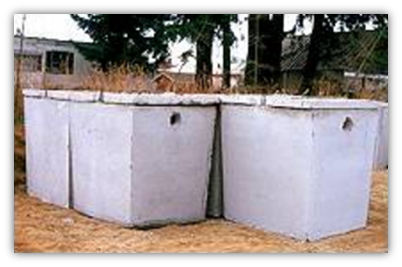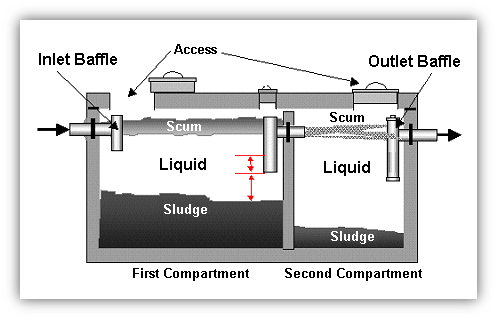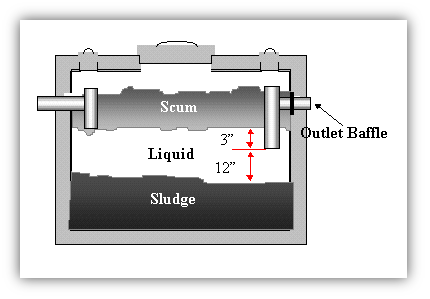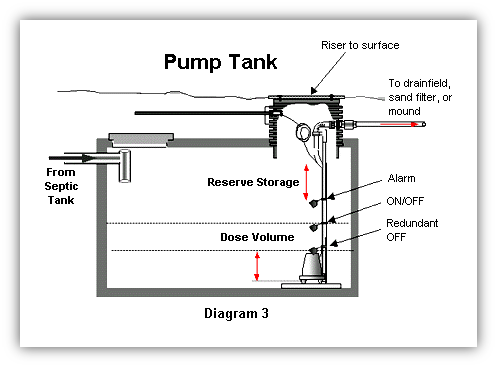A septic system has two main parts: a septic tank and a drainfield
Septic tanks
Septic tanks above ground
Double compartment septic tanks:
Solids that are not decomposed remain in the septic tank. If they are not removed by periodic pumping, solids continue to accumulate until they over-flow into the drainfield. This eventually leads to drainfield plugging and drainfield failure. The first signs may be slow draining fixtures, however the system may fail by discharging sewage effluent to the ground or back-up into the house as well (see below.)
Double compartment septic tank anatomy
Single compartment septic tanks:
Most septic tanks need to be pumped every 3-5 years, depending on the tank size, the amount of solids entering the tank and the habits of the users. The only sure way to know is to have the septic tank inspected annually. By measuring the sludge and scum layer thickness it can be determined when the tank needs to be pumped. The septic tank should be pumped whenever: the bottom of the scum layer is within 3 inches of the bottom of the outlet baffle or the top of the sludge layer is within 12 inches of the bottom of the outlet fitting (See below).
Single compartment septic tank anatomy
Wastewater leaving the septic tank is a liquid called effluent. While it has received some treatment in the septic tank it is still unpleasant smelling and contains disease organisms, organic wastes and other pollutants. This effluent requires proper treatment and disposal otherwise there can be significant environmental and public health problems. Discharging effluent onto the ground or into surface and ground water is against Washington State law and King County Board of Health Codes.
Pump tanks:
Some system types in addition to a septic tank have a pump tank. This pump tank contains a sewage effluent pump, control floats, and a high water alarm. The control floats are set so that a specific volume of effluent is sent to the drainfield. This specific amount is referred to as a dose. When the effluent in the pump tank rises to the level of the “on” float the pump is activated and pumps the level of the effluent down until it reaches the “off” float setting (See Diagram 3 below.)
Pump tank anatomy
Should the “on” float fail to activate the pump or should the pump itself fail the level of effluent in the pump tank will continue to rise in the pump chamber. When this level reaches the alarm float an audible and visual signal will be activated. The location of the alarm device should be known by the homeowner (see your as-built information for details). The alarm device is commonly located under the kitchen sink or in the garage. Once this alarm is activated there is some emergency storage space available in the pump tank before the system actually over flows or backs up into the house. The audible signal can be deactivated but this will not solve the problem. You should immediately begin emergency water conservation measures and call a On-site System Maintainer or contact the Eastgate Health District Office at 206-477-8050 for more information.
Drainfields
The drainfield is where liquid from the septic tank flows through pipes in your yard for final treatment by organisms in the soil. Grass and/or shallow-rooted plants are the best covers for your drainfield. See Landscaping tips with a septic system for more information.
Don’t park cars and trucks on the drainfield or septic tank. Also, don’t install driveways, patios, carports, decks, storage sheds, sports courts, landscaping plastic, and/or allow animals to graze. These activities pack soil and may lead to pipes breaking.
Your yard should also have a “reserve area” which is where your replacement drainfield will be located if your drainfield fails.
See brochure on “Understanding and Caring for Your Septic Tank System” by the Washington State Dept. of Health.
Source: http://www.kingcounty.gov/depts/health/environmental-health/piping/onsite-sewage-systems/maintenance/how-OSS-works.aspx





Recent Comments